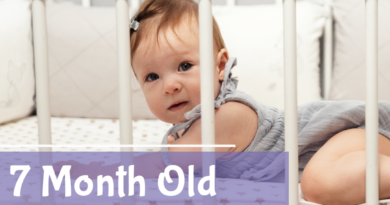How to Room Share with a Baby
If you are a parent who is room sharing with your baby— either because you have your family in a small space or you want to share with your baby, I am going to share some tips and strategies for you today.
AAP GUIDELINES FOR ROOM SHARING
Before we jump in, let’s review the American Academy of Pediatrics’ suggestions. The AAP suggests room sharing for up to six months of your child’s first year. In fact, they say up to a year is recommended, but here’s the thing: this is a suggestion, not a rule. This is not a mandate. So their suggestion is that you room share up to 6 months. If you can, up to 12 months of age with your baby.
There are many different types of parents out there. You may be a parent who feels like you must abide by the rules. And if that’s you, I’m here to tell you that it’s not a rule.
It’s a suggestion. I believe it’s up to you as the parent to decide when you would like to room share and when to stop. You can choose what’s best for your baby!
WHAT IS ROOM SHARING?

Let’s make some distinctions when it comes to room sharing, co-sleeping, and bed-sharing.
- Room sharing: Room sharing is when you are sharing the same room as your child, but you each have your own beds.
- Bed-sharing: This is when your child is in the same bed as you. I do not promote bed-sharing. I have had parents email me and ask me to talk about safe bed-sharing. Unfortunately, that’s not my sleep philosophy. If you would like to discuss safe bed-sharing, there are platforms that discuss that sleep philosophy. If you are going to bed-share, you cannot have pillows, blankets, sheets, or any other item in the bed.
- Co-sleeping: I refer to co-sleeping as your child sharing the same room as you, but not in your bed. Again, I do not promote bed-sharing.
That’s why I prefer to use the term room sharing because it’s very clear that you’re not bed-sharing, you’re just sharing a room.
HOW TO SET UP YOUR BEDROOM WITH ROOM SHARING
When we’re talking about room sharing, there are a few things we need to do to set up your bedroom for success.
 The first thing I am going to check is the distance between your crib and your side of the bed. After 8 weeks (recognizing that in those early days you need them closer), I want the crib to be on the opposite side of your bedroom.
The first thing I am going to check is the distance between your crib and your side of the bed. After 8 weeks (recognizing that in those early days you need them closer), I want the crib to be on the opposite side of your bedroom.
Even if your child has been sleeping all night, if they are just a few feet away from you, you are going to hear every little move and sound. If you have a baby that you need to share a space with, please move them away from you so you can get more sound sleep.
 Even with room sharing, the darker the room, the better the sleep.
Even with room sharing, the darker the room, the better the sleep.
I am going to recommend The SlumberPod for long-term room sharing situations. When you room share, a pack n play can be safely covered with a SlumberPod to keep the sleeping environment dark. (Plus, when you use this link, you’ll save 5% on The SlumberPod!)
Even without a SlumberPod, there are a lot of other darkening options. I have a whole blog post here where you can see my best blackout solutions!
 After you explore crib placement and darkness in the room, you should explore white noise next. Now, when we have a white noise machine in your child’s room, I advocate for a volume of 50 decibels.
After you explore crib placement and darkness in the room, you should explore white noise next. Now, when we have a white noise machine in your child’s room, I advocate for a volume of 50 decibels.
That’s the loudest it should be for safety reasons. If you don’t know your machine’s level, you can download a free decibel reader app. Measure the decibel level near your child’s crib space. The white noise machine should be at least three feet from your child’s crib space too.
 After setting up all of these room sharing strategies, walk around the room and look for paths that might be squeaky. Think about your morning and evening routine. Check for door squeaks and correct them with WD-40. Block squeaky floor areas, if you safely can, with furniture to avoid noisy floorboards.
After setting up all of these room sharing strategies, walk around the room and look for paths that might be squeaky. Think about your morning and evening routine. Check for door squeaks and correct them with WD-40. Block squeaky floor areas, if you safely can, with furniture to avoid noisy floorboards.
HOW TO RESPOND TO YOUR CHILD IN THE MIDDLE OF THE NIGHT
When you room share, responding to your child in the middle of the night can be a more tricky situation to navigate because your child is aware you are in the room. If they can see you, it’s even worse (that’s why I advocate for the SlumberPod). So here are some of my tips on how to navigate your baby waking up in the middle of the night.
Tip #1: If you have a 4-month old or older baby who is waking in the middle of the night, that is tough on everyone’s sleep! When you begin sleep training at this age, I recommend moving out of the room for a few nights when it is most difficult. It will be SO much easier for you to be consistent with your plan.
Tip #2: Additionally, if you have access to a ventilated closet, this makes a great space for an in-room nursery. (My daughter Hattie slept in a closet for 8 months of her life and she was the happiest baby!!)
Tip #3: Babies are notorious for having wakings throughout the night, but during some of those wakings, they’re not fully alert and awake. They are actually cycling in and out of their sleep. Have you ever noticed that this almost happens every hour and a half throughout the night?
There’s a reason for that— it’s the length of a sleep cycle. It’s very normal for them to cry out or make noise during this time. So, one of my recommendations is to just wait. Often they will go back to sleep.
CONCLUSION
You need to know that you can successfully room share. Here are my top tips:
- Know the difference between room sharing, bed-sharing, and co-sleeping! I only advocate for sharing a room, not a bed, based on AAP guidelines for safe sleep.
- Set your room up for success! Keep your baby an appropriate distance from you, make your room (or their crib if you’re using a SlumberPod!) as dark as possible, use white noise, and check for squeaks!
- Have an age-appropriate plan for responding to your child in the middle of the night.
Be encouraged today that wherever you are and whatever you’re doing, you can make the decision that you believe is best for your family.
You can make sleep a thing for your family, even when you room share!
LOVE THIS? PIN IT FOR LATER!





